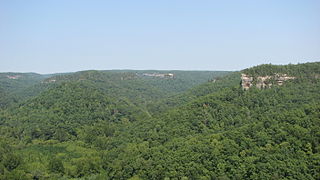History
Early plans for the arboretum began in 1858 when Jesse W. Fell, founder of Illinois State University, contacted landscape designer William Saunders (botanist). Saunders planned a layout for what would eventually become The Quad for the university's campus. [1]
In 1867, Jesse Fell obtained $3,000 from the state legislature for campus landscaping. [1] Fell planted 1,740 trees on campus that year and 107 trees the following year. An enthusiastic tree planter, Fell wished the campus to contain every tree native to Illinois. In 1995 the campus was formally registered as an arboretum and named in Fell's honor. [2]
The arboretum is an ArbNet Level II accredited arboretum. [3]

The University of Delaware Botanic Gardens are botanical gardens and an arboretum located on the campus of the University of Delaware, in Newark, Delaware, United States. The gardens are open to the public without charge.

The Donald E. Davis Arboretum, in Auburn, Alabama, United States, is a public native plants museum, and botanical arboretum with educational facilities, event spaces, and a conservation program. Its grounds, covering 13.5 acres of Auburn University's campus, include cataloged living collections of associated tree and plant communities representative of Alabama's ecosystems, among which is mixed oak forest, carnivorous bog, and longleaf pine savanna. The living collections include more than 1,000 plant types, including 500 different plant species, with over 3,000 cataloged specimens. The Arboretum contains over a mile (2 km) of interwoven walking trails that meander through various southeastern biotopes.
The Alice Abel Arboretum is a 25 acres arboretum located at 5000 St. Paul Street on the campus of Nebraska Wesleyan University in Lincoln, Nebraska.

The Salisbury University Arboretum, formerly known as the Salisbury State University Arboretum, is an arboretum on the campus of Salisbury University, 1101 Camden Avenue, Salisbury, Maryland.
The Morrison Arboretum is an arboretum located in Morrison, Oklahoma. It is open to the public daily without charge.
The Idaho State Arboretum is an arboretum located across the campus of the Idaho State University, Pocatello, Idaho, United States. It is open to the public daily without charge and includes an organized tree walk.

Nichols Arboretum, locally known as the Arb, is an arboretum operated by the Matthaei Botanical Gardens and Nichols Arboretum (MBGNA) at the University of Michigan. Located on the eastern edge of its Central Campus at 1610 Washington Heights in Ann Arbor, Michigan, the Arboretum is a mosaic of University and City properties operated as one unit. The arboretum is open daily from sunrise to sunset with no charge for admission. The Huron River separates a northern section of the arboretum's floodplain woods; the railroad marks the northern border.

Peavy Arboretum is an arboretum operated by Oregon State University and located on Arboretum Road, Corvallis, Oregon. It is open to the public daily without charge.

The Appalachian mixed mesophytic forests is an ecoregion of the temperate broadleaf and mixed forests biome, as defined by the World Wildlife Fund. It consists of mesophytic plants west of the Appalachian Mountains in the Southeastern United States.
The Museo e Arboreto Carlo Siemoni is a museum and historic arboretum located in Badia Prataglia, Poppi, Province of Arezzo, Tuscany, Italy.
The Jardin botanique de Tourcoing is a municipal botanical garden and arboretum located at 32 rue du Moulin Fagot, Tourcoing, Nord, Nord-Pas-de-Calais, France. It is open daily; admission is free.

Weeping trees are trees characterized by soft, limp twigs. This characterization may lead to a bent crown and pendulous branches that can cascade to the ground. While weepyness occurs in nature, most weeping trees are cultivars. Because of their shape, weeping trees are popular in landscaping; generally they need a lot of space and are solitary so that their effect is more pronounced. There are over a hundred different types of weeping trees. Some trees, such as the cherry, have a variety of weeping cultivars. There are currently around 550 weeping cultivars in 75 different genera, although many have now disappeared from cultivation.
This page is based on this
Wikipedia article Text is available under the
CC BY-SA 4.0 license; additional terms may apply.
Images, videos and audio are available under their respective licenses.








